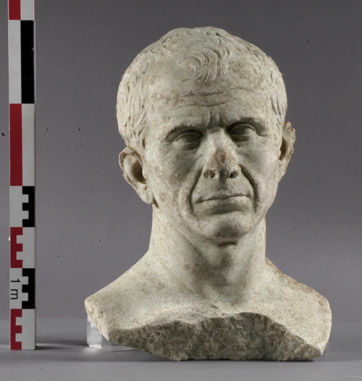A pile of folks have sent various versions of this one in (thanks!) ... here's the version from the Australian:
All the articles are accompanied with some version of this photo found at the French Ministry of Culture site:

I dunno ... definitely Republican, style-wise, but it doesn't look like Julius Caesar to me other than the two vertical wrinkles between the brows ... I wonder what the identification was based on ...
UPDATE: Mary Beard and Rick Darby are also doubting the Caesar identification
UPDATE II: Mary Jane -- in a comment at the Numismatics and Archaeology blog -- offers an excellent list of reasons why the bust isn't JC ....
A BUST of Julius Caesar, believed to be the oldest representation of the Roman emperor yet known, has been found at the bottom of the River Rhone.
Caesar
The life-sized bust showing the Roman ruler as a balding and ageing man with wrinkles and hollows in his face is tentatively dated to 46 BC.
Divers trained in archaeology uncovered the marble bust and a collection of other finds in the Rhone River near the town of Arles in the south of France.
Among other items in the treasure trove of ancient objects found in the bed of the river was a 1.8m marble statue of Neptune, dated to the first decade of the third century after Christ.
Two smaller statues were also found, both in bronze and measuring 70cm each.
One of them, a satyr with his hands tied behind his back, "doubtless" originated in Hellenic Greece, the ministry said.
"Some (of the discoveries) are unique in Europe," Culture Minister Christine Albanel said. The bust of Caesar is in a class by itself.
"This marble bust of the founder of the Roman city of Arles constitutes the most ancient representation known today of Caesar," the ministry statement said, adding that it "undoubtedly" dates to the creation of Arles in 46 BC.
Among other things, researchers are trying to uncover "in what context these statues were thrown into the river", said Michel L'Hour, who heads the Department of Subaquatic Archaeological Research, whose divers made the discovery between September and October 2007.
The site "has barely been skimmed", L'Hour told The Associated Press, adding that a new search operation will begin this summer.
With its Roman beginnings, the area around Arles in the Provence region of southern France and the Rhone are "propitious" for discoveries, L'Hour said.
All the articles are accompanied with some version of this photo found at the French Ministry of Culture site:

I dunno ... definitely Republican, style-wise, but it doesn't look like Julius Caesar to me other than the two vertical wrinkles between the brows ... I wonder what the identification was based on ...
UPDATE: Mary Beard and Rick Darby are also doubting the Caesar identification
UPDATE II: Mary Jane -- in a comment at the Numismatics and Archaeology blog -- offers an excellent list of reasons why the bust isn't JC ....
